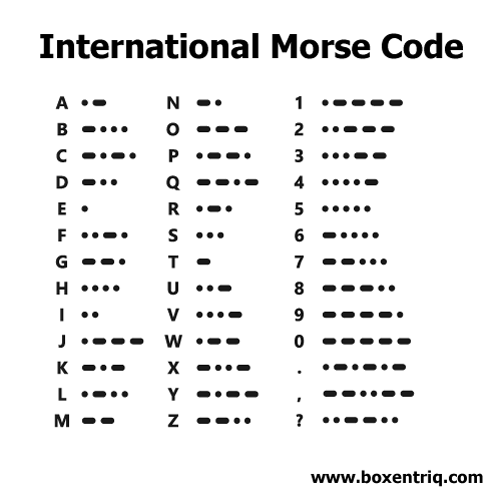Free Morse Code translator with support for many languages. Easily convert text to Morse code or Morse code to text.
Translate Morse Code
Mode
Morse characters
| - | Dash |
| . | Dot |
| Space | Letter separator |
| / | Word separator |
| # | Untranslatable character |
Morse Code Conversion Chart
Morse Code translation
Features
- Morse code is a forms of communication named after Samuel Morse, one of the inventors of the telegraph. The Morse alphabet became a worldwide standard in 1865. It has been widely used in the maritime world until the end of the 20th century.
- The Morse alphabet is designed so that the most frequent letters in the English alphabet has the shortest codes. This makes transmission much faster than if all letters would have equal length codes.
- The International Morse Code includes the English letters, some extra Latin letters, the Arabic numerals and a small set of punctuation and procedural signals.
- Letters are separated by a space of duration equal to three dots. Words are separated by a space equal to seven dots.
- Morse code can be transmitted in many ways such as by electric signal, flashing light, vibration, etc.
- There are also special Morse alphabets for other languages than English.
Morse code is frequently used in geocaching mystery caches (puzzle caches), CTFs and logic puzzles.
History
The development of the earliest telegraph systems started in the 19th century following the discovery of electromagnetism in 1820. Samuel Morse, together with Joseph Henry and Alfred Vail invented a simple telegraph system that used only electrical pulses and silence between them. Morse's original telegraph receiver used a clockwork and an electromagnet to mark the received pulses onto a paper tape. Operators could then translate the markings on the paper tape into text messages.
Alfred Vail estimated the frequency of letters in the English language and assigned the letters most commonly used the shorter Morse code sequences, while the more infrequent letters were assigned longer sequences. This code was first used in 1844 and was called Morse landline code, or American Morse code.
Morse operators soon learned that the telegraph was making sounds when receiving the code and that they could translate the sound instead of looking at the paper tape. They learned the sound patterns of the Morse code. This made the paper tape unnecessary. Later, Morse code was adapted to radio communications by transmitting the pulses as short and long tones.
A new and improved version of the Morse code alphabet was proposed by Friedrich Clemens Gerke in 1848, that was adopted by the German-Austrian Telegraph Society. This finally led to the International Morse Code standard (ITU) in 1865, that is still being used today.
Timing and speeds
Morse code can be transmitted in multiple ways such as sounds, a common flashlight, electrical pulses on a telegraph line, mechanical, etc. There are even examples of using morse code during mine rescues by pulling a rope. Historians have called morse code the first digital code.
International Morse code (ITU) consists of five elements:
- Short mark, "dot" or "dit" (.), which is one time unit long
- Long mark, "dash" or "dah" (-), which is three time units long
- Within-character gap, between the dots and dashes within a morse character, which is one time unit long
- Between-characters gap, which is three time units long
- Between-words gap, which is seven time units long
These five elements can also be expressed as binary codes:
- Short mark, "dot" or "dit" (.): 1
- Long mark, "dash" or "dah" (-): 111
- Within-character gap, between the dots and dashes within a morse character: 0
- Between-characters gap: 000
- Between-words gap: 0000000
Note that marks and gaps always alternate. There are never two marks in a row, or two gaps in a row.
Words per minute
Morse code speed is commonly measured in words per minute. This is not unproblematic, because words can have different lengths and the letter can have different dot lengths. Therefore typical words such as "PARIS" (which is 50 time units long) or "CODEX" (which is 60 time units long) are used to measure the speed. A more precise way to measure Morse code speed is therefore specifying the time unit length (dot duration).
Farnsworth speed
When learning Morse code, people often use something called Farnsworth speed (or Farnsworth timing) to make it easier to recognize the Morse code characters. Instead of slowing everything down, the individual characters are played at a normal speed, but the pauses (gaps) between them are made longer to give more time to understand them.
Examples
Translate text to Morse code
Enter this text into the Morse code translator input box above:
Boxentriq
You should see this result:
-... --- -..- . -. - .-. .. --.-
Translate Morse code to text
Enter this text into the input box:
.- .-.. .--. .... .- -... . -
You should see this result:
ALPHABET
International Morse code overview

Sample text



The images above represents the text "BOX" written in Morse code.
See also: Code-Breaking tools | Braille | Dancing men cipher | Elder futhark | Greek alphabet | Hexahue | International code of signals | Semaphore flags | Tap code